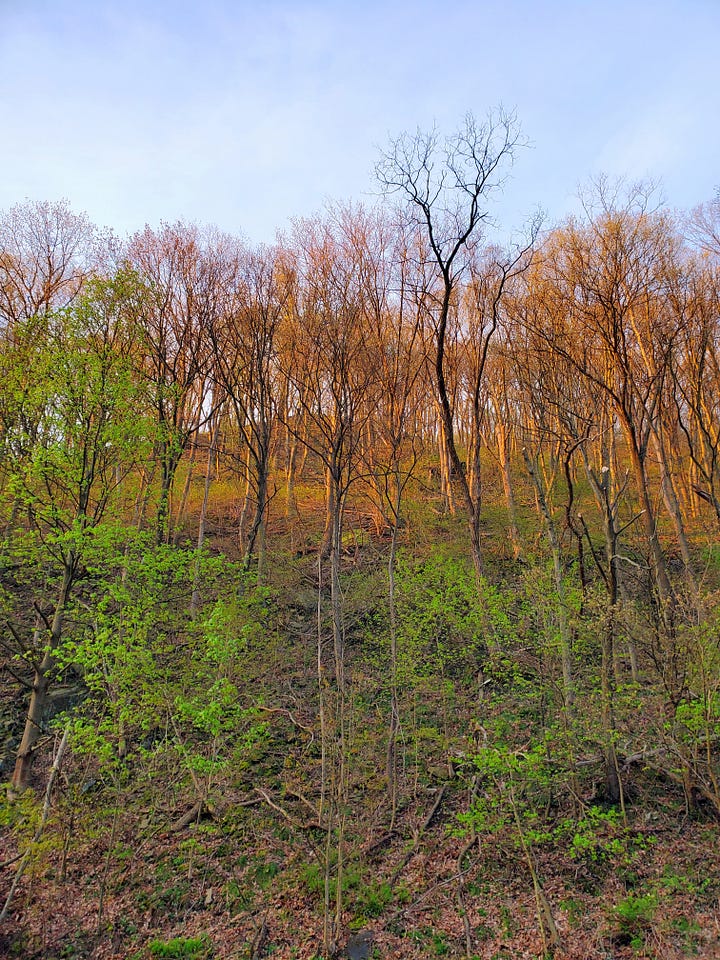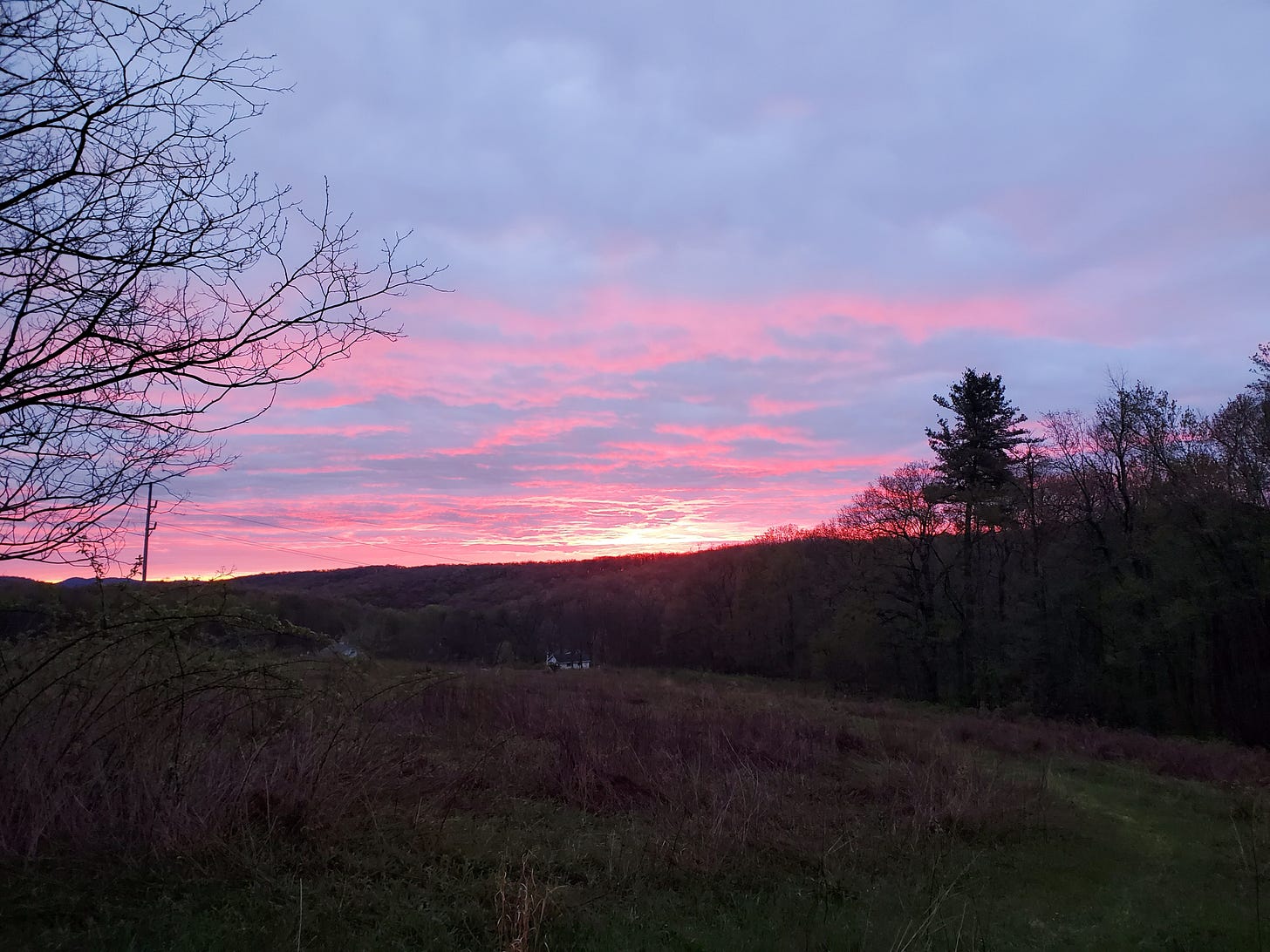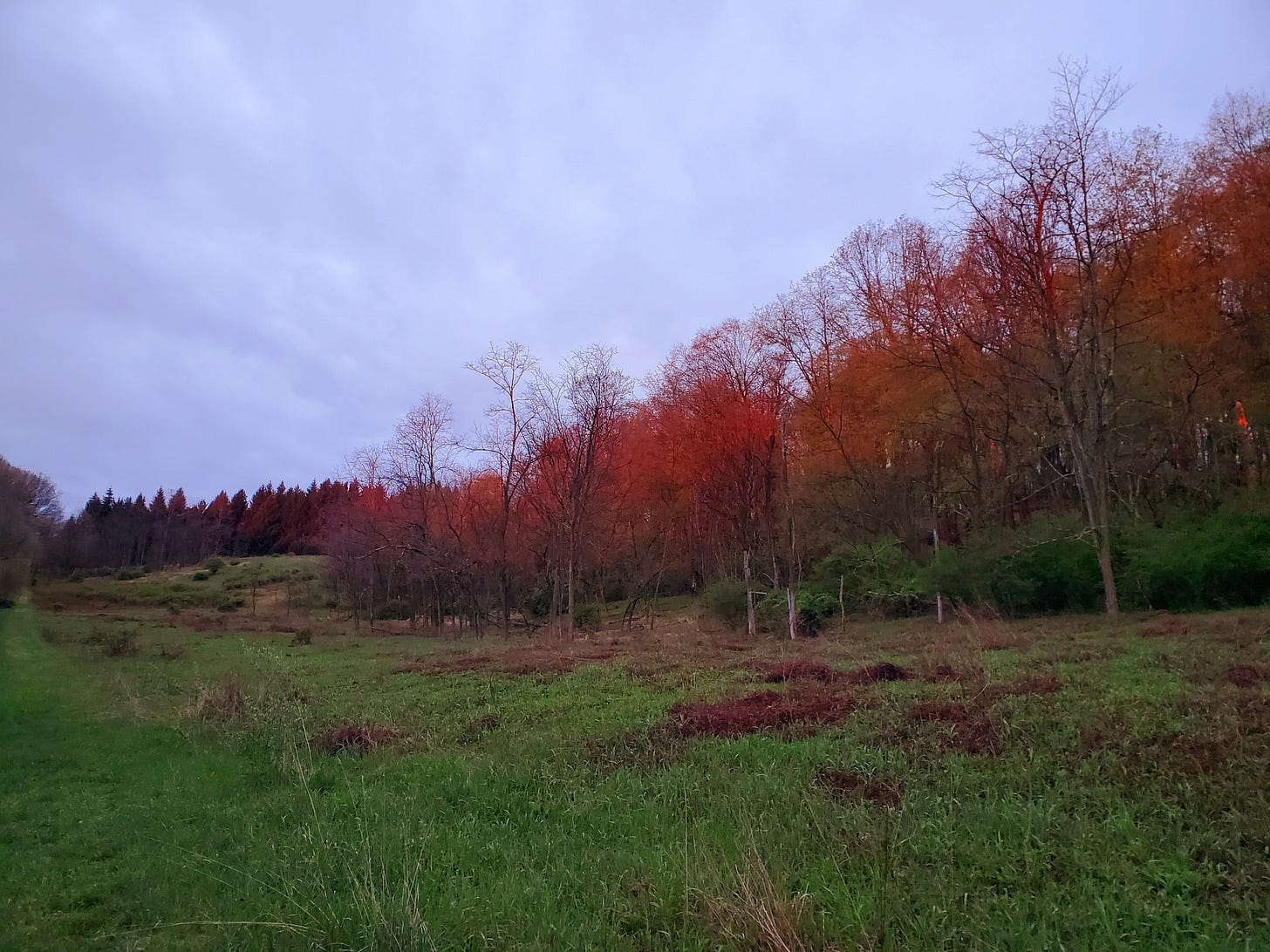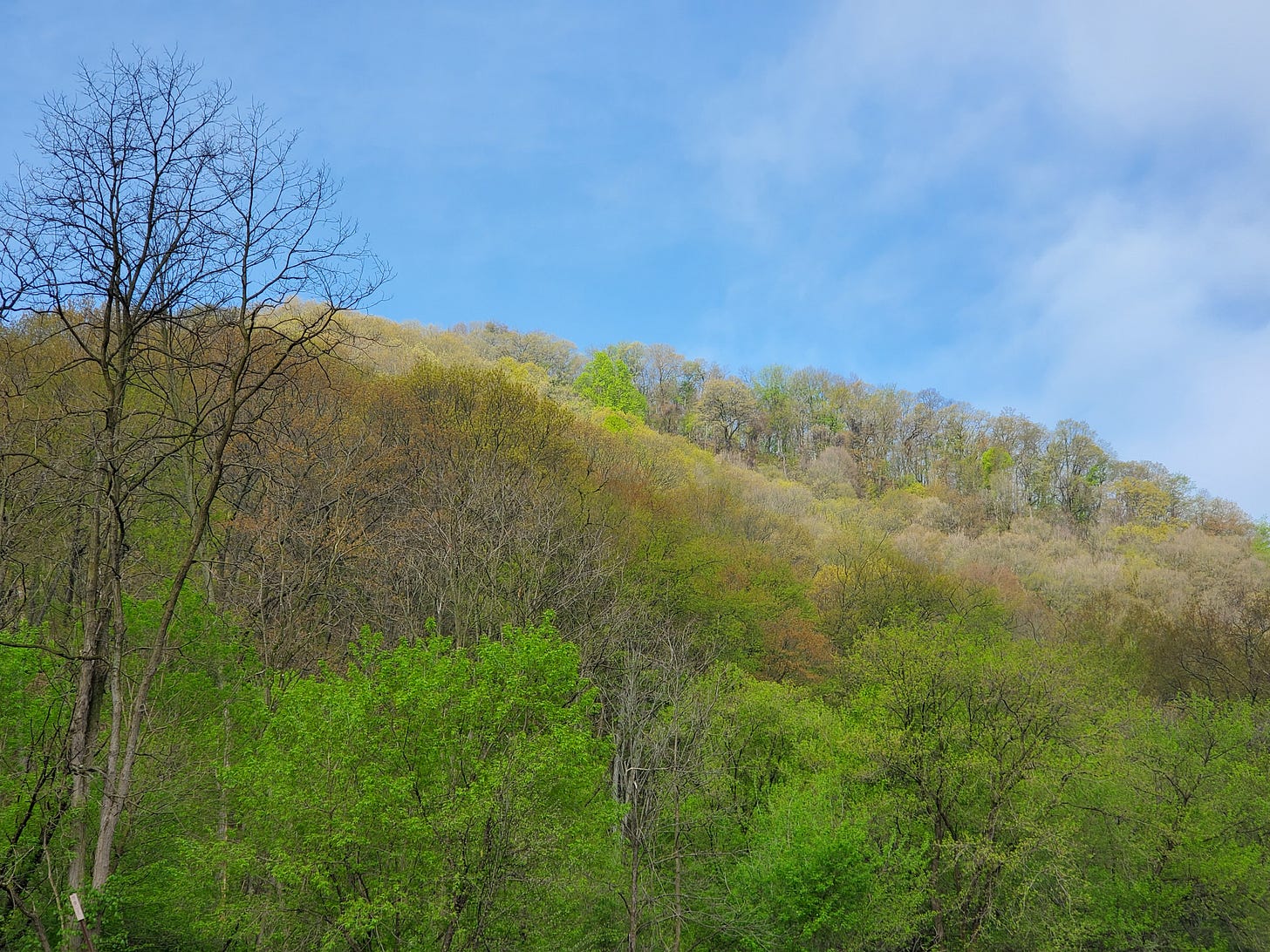Week 17 (Apr 22-28 2024)
Highlights
First-of-year (FOY) on NFCs: Indigo Bunting and Veery (Sat); Swainson’s Thrush, Solitary Sandpiper, Spotted Sandpiper, Black-billed Cuckoo (Sun)
Balcony FOYs: Warbling Vireo (Tues); Bank Swallow and Ruby-throated Hummingbird (Sun)
FOYs along the tracks: Gray Catbird (Wed); American Redstart and Common Yellowthroat (Sat); White-eyed Vireo (Sun)
Mountaintop FOYs: Hooded Warbler and Ovenbird (Thurs); Rose-breasted Grosbeak, Scarlet Tanager, Blackburnian Warbler, Great Crested Flycatcher (Fri); Cerulean Warbler (Sat); Nashville Warbler, Worm-eating Warbler, Yellow-throated Vireo, Red-eyed Vireo (Sun)
25 FOYs = 148 species for 2024
Log
Apr 22 (Mon). AM: 27 spp. (balcony, 1 hr.)
Apr 23 (Tues). AM: 42 spp. (1.3-mi. hike, 2 hrs. 30 min.); PM: 28 spp. (balcony, 2 hrs. 20 min.)
Apr 24 (Wed). AM: 48 spp. (1.4-mi. hike, 2 hrs.)
Apr 25 (Thurs). AM: 47 spp. (1-mi. hike, 2 hrs. 20 min)
Apr 26 (Fri). AM: 50 spp. (3-mi. hike, 2 hrs.)
Apr 27 (Sat). AM: 40 spp. (2-mi. hike, 1hr. 40 min.); 38 spp. (0.25-mi. hike, 40 min.)
Apr 28 (Sun). AM: 54 spp. (2-mi. hike, 1 hr. 45 min.); AM: 64 spp. (2-mi. hike, 2 hrs.); PM: 25 spp. (balcony, 25 spp.)


On Tuesday by 5:43 AM, with the temperature barely above freezing, one Louisiana Waterthrush is already singing and on the move below the tracks while another sings from up on the ridge somewhere. Chickadees and titmice are also among the earliest risers now, well before 6.
At the pond, a Mallard drake and Canada Goose both shovel away, keeping each other company. Something like a Green Heron flies off, eluding me.
The deer’s head has been dragged away, and after half a year, the beast is now merely bits and pieces.
A brown Northern Harrier crosses the Gap, heading north, and a single Wood Thrush sings from near the crossing. Seven Double-crested Cormorants float into sight above Bald Eagle Mountain, also trending northward. A rumbling, stinking train stops long enough for me to learn something.





Back at the apartment, the Northern Rough-winged Swallow pair is vigorously chasing and chittering, stopping to perch on the lowest wires. The Barn Swallow, however, is still alone, going on a week now. I’m beginning to feel sorry for it (him?).
Close to eight, new music: the Warbling Vireo is back! Invisible, as always, it warbles, House Finch-like, from inside a leafing sycamore.
In the late afternoon, a trio of Fish Crows invades the downtown, later swelling to nine.
The Catbird’s Meow
On Wednesday, the warm-up continues after days of colder weather that had made the migrant wave of last week a distant memory. Back on the tracks, a meow and then a crackle issue from the thick bank of privets and rotten trunks just beyond the interstate: first Gray Catbird. Farther on, above the private jungle on our side, the single Wood Thrush sings louder than it did yesterday.
A Northern Cardinal, deep in the privet, panics, though not at my presence. I would guess it’s protecting a nest.
Overhead, there are more Common Mergansers now than Mallards, and I can’t say I’m complaining. At the pond, a Warbling Vireo sings, claiming another piece of the hotspot’s prime real estate.
Later, as I’m taking off my boots back at the balcony, the robin-grackle drama explodes again down in the gravel. The two adversaries scratch and scream and jump, battering their wings and beaks. This time, they’re fighting over some object on the ground, but the grackle gets the worst of it and flees. The robin struts around its prize, pecking at the better part of one of those large and overly sweet chocolate chip cookies. The lump turns out to be rather unappealing, however, and the robin flies back up into its nest under the eave, leaving its spoils for the ants.
Two More
On Thursday, the sky is spitting and it’s raw and chilly, not yet the kind of weather to herald the next wave of migrants, still bottled up in the South somewhere. Cardinals and towhees are already at it before 5:30, and the Eastern Whip-poor-will, undeterred by the chill, starts up ten minutes later from off in the mountain laurel.
As the sodden gloom turns to sun, a Hooded Warbler sings from one of the thickets along the neck of First Field. A bit later, an Ovenbird’s rollicking song erupts from Laurel Ridge. (Later, I find Ovenbirds all over the night flight spectrum, and even the first of its night songs.) I walk rapidly to the Far Field and back, but nothing else new is about. Along the road in Roseberry Hollow, I hear a whining and complaining coming from deep inside a sugar maple, and as I peer in a hole, a furry bulk hefts itself up out of sight, leaving three squirming baby raccoons to mew helplessly.
Second Wave
Friday week, an abnormally early wave of Neotropical migrants left a few Wood Thrushes and Black-and-white Warblers in its wake, but we’re still waiting for the main group of late April arrivals. Today, it’s cold but crystal clear, and the plan is to hike right up the Sapsucker knife-edge to see if any of them have trickled into the woods up in Hanging Hollow.
Rival Louisiana Waterthrushes are singing from perches a couple hundred feet above the stream. The boundary of their breeding territory seems to be somewhere along the road above the gate, with one claiming the Railroad Hollow, both sides of the tracks, and the stream down to the river, and the other the lowest interior of the main Hollow. By 6 AM, both birds have left their high spots and headed back down.
I guessed right. The first new arrivals to sound off are Blackburnian Warblers, soon to claim a line of territories stretching all the way up to the spruce grove. As the woods erupts in song, a Scarlet Tanager and a Rose-breasted Grosbeak are next. Perhaps these all arrived last night, but more likely, they’ve been up here for a few days already.
I walk the high circuit as Wood Thrushes sing from all around, eight in all, more than eBird is accustomed to for this early date. Black-throated Green and Black-and-white warblers are also back in numbers, and two more Ovenbirds as well. Blue-gray Gnatcatchers provide constant background noise. By the time I reach Dogwood Knoll my brain is dizzy with the buzzing of American Goldfinches; one sounds like it’s imitating the “chuck-chuck-chuck” of a Northern Cardinal. And then, from up in the tallest trees, among the emerging caterpillars, a Great Crested Flycatcher reeps.
Down in the Hollow, it’s dead silent, all songs above obliterated by the rushing water.
My goal this week and next is to see how many species can be detected in April; the list is already well ahead of last year. The more I can find, the more my May senses can focus on the scarcer species, less distracted by the rapidly swelling chorus of common birds.
In town, the Barn Swallow still sits, alone, on the wire.
The Warblers of Redstart Swamp
Every day that I’ve passed by Redstart Swamp I’ve been disappointed—no sign of Yellow-throated Warblers deciding to stay and breed, and no Yellow Warblers showing up to claim territory, either. With broiling temperatures on the way starting Sunday, there’s no need to rush things, but I do like to intercept each species at what I suppose is choice real estate.
The warm-up begins on Saturday, with 48 degrees already by 5 AM. A pair of Eastern Phoebes are loudly disputing the snags around the swamp, and flying across the tracks to the toe of Laurel Ridge and the woods fringing the pond. At 5:55, the first wichity-wichity-wichity of the year gives away a Common Yellowthroat, barely ahead of the crowds that will arrive to the fields up on top. I face the swamp in anticipation.
At two minutes until six, a series of loud chips issues from a few feet in front of me, and quickly gives way to a soft weezy series of a male American Redstart.
Later, a male Wood Duck, calling loudly, sails past me and drop down into the pond.
In the afternoon, a text from Dave: FOY Cerulean Warbler, up on Sapsucker Ridge. Around 6 PM, a cloud of 40 Chimney Swifts is hawking for bugs over the confluence, the first large group of the season. In the night, the first Indigo Bunting buzzes over, and then the first Veery.
In the night between Saturday and Sunday the migrant flow continues, with the first Swainson’s Thrush among Veeries, Hermit Thrushes, and Wood Thrushes. The two most common May shorebirds, Spotted Sandpiper and Solitary Sandpiper, both show up, and a low chuckle gives away a Black-billed Cuckoo, slightly ahead of the Yellow-billed again this year.
Sunday dawns foggy, in the 50s by 5 AM, with a cardinal already singing along the edge of the field somewhere. Then minutes of nothing, until a White-throated Sparrow breaks the silence at 5:38. After that comes a deluge of song, which doesn’t abate for an hour, by which time 50 species have sounded off. In all that time, I haven’t walked beyond a small patch of field in the neck. Every species is where and when it should be, with all the warblers singing once or more between 6 and 6:20 AM, as expected. A Nashville Warbler is the lone new species up here, but later, down in the Hollow, I hear a handful of Worm-eating Warblers.
Red-eyed and Yellow-throated vireos have both arrived as well, but the biggest surprise of the day, and indeed of the last few weeks, is a calling White-eyed Vireo from the thicket just on the town side of the gate, in a favorite spot for this scarce species. This is the first time we’ve recorded it in April—like almost everything else, it’s running a week ahead of schedule.
The week winds down with two days to go in the month, and ten species ahead of 2023. An hour on the balcony in the mid-afternoon yields the first and possibly only Bank Swallow over the confluence and a flyby Ruby-throated Hummingbird. Definitely time to put out the feeders.








